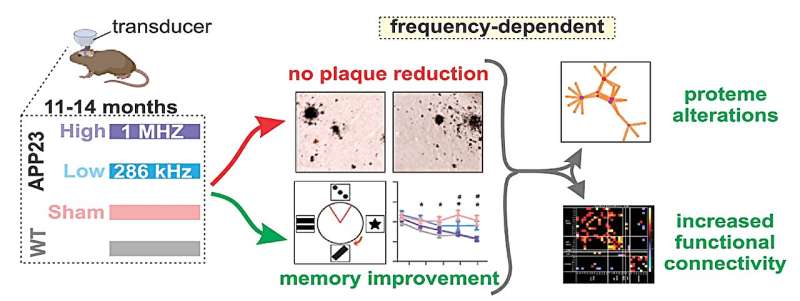
University of Queensland researchers have found targeting amyloid plaque in the brain is not essential for ultrasound to deliver cognitive improvement in neurodegenerative disorders.
Dr. Gerhard Leinenga and Professor Jürgen Götz from UQ’s Queensland Brain Institute (QBI) said the finding challenges the conventional notion in Alzheimer’s disease research that targeting and clearing amyloid plaque is essential to improve cognition.
“Amyloid plaques are clumps of protein that can build up in the brain and block communication between brain cells, leading to memory loss and other symptoms of Alzheimer’s disease,” Dr. Leinenga said.
“Previous studies have focused on opening the blood-brain barrier with microbubbles, which activate the cell type in the brain called microglia which clears the amyloid plaque.
“But we used scanning ultrasound alone on mouse models and observed significant memory enhancement.”
Dr. Leinenga said the finding shows that ultrasound without microbubbles can induce long-lasting cognitive changes in the brain, correlating with memory improvement. The research paper has been published in Molecular Psychiatry.
“Ultrasound on its own has direct effects on the neurons, with increased plasticity and improved brain networks,” he said.
“We think the ultrasound is increasing the plasticity or the resilience of the brain to the plaques, even though it’s not specifically clearing them.”
Professor Götz said the study also revealed the effectiveness of ultrasound therapy varied depending on the frequency used.
“We tested two types of ultrasound waves, emitted at two different frequencies,” he said. “We found the higher frequency showed superior results, compared to frequencies currently being explored in clinical trials for Alzheimer’s disease patients.”
The researchers hope to incorporate the findings into Professor Götz’s pioneering safety trial using non-invasive ultrasound to treat Alzheimer’s disease.
“By understanding the mechanisms underlying ultrasound therapy, we can tailor treatment strategies to maximize cognitive improvement in patients,” Dr. Leinenga said.
“This approach represents a significant step toward personalized, effective therapies for neurodegenerative disorders.”
More information:
Gerhard Leinenga et al, Scanning ultrasound-mediated memory and functional improvements do not require amyloid-? reduction, Molecular Psychiatry (2024). DOI: 10.1038/s41380-024-02509-5
Citation:
Ultrasound therapy shows promise as a treatment for Alzheimer’s disease (2024, April 2)
ultrasound-therapy-treatment-alzheimer-disease.html
.
. The content is provided for information purposes only.
